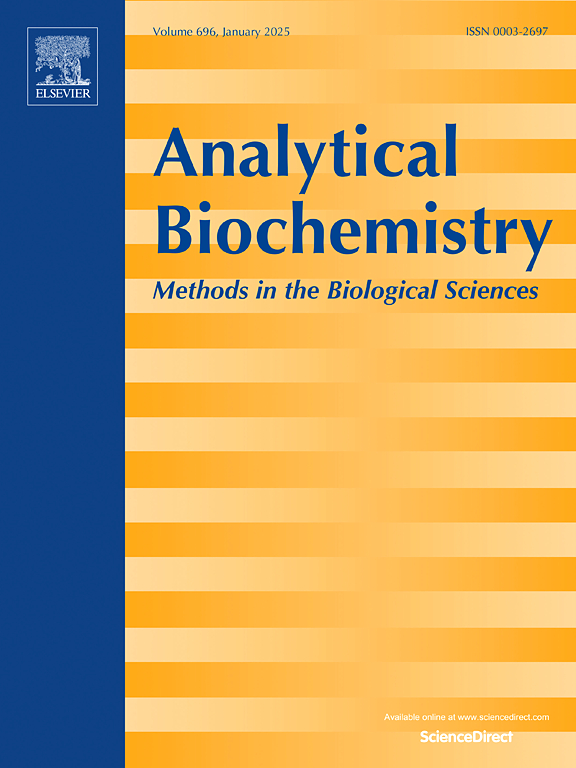壳聚糖稳定的氧化铜纳米颗粒:抗坏血酸传感的新型比色法
IF 2.5
4区 生物学
Q2 BIOCHEMICAL RESEARCH METHODS
引用次数: 0
摘要
抗坏血酸与坏血病、氧化应激、心血管疾病等多种疾病有关。本文首次采用一种简单有效的方法合成交联壳聚糖稳定的氧化铜纳米颗粒(CuO@C-CS),这是一种无毒且可生物降解的方法。各种光谱技术,包括FTIR, XRD, SEM, EDX, TGA和元素映射,证实了材料的合成。合成的纳米酶(CuO@C-CS)在过氧化氢的辅助下,通过显色底物3,3 ',5,5 ' -四甲基联苯胺(TMB)作为过氧化物酶模拟物检测抗坏血酸。合成的模拟酶将无色的TMB转化为oxTMB。抗坏血酸的感知是通过模拟酶的过氧化物酶样抑制活性以及oxTMB的还原来实现的。结果表明,该传感器系统的检测限为0.24 μM,定量限为0.80 μM,线性范围为1 ~ 96 μM,回归系数为0.999。在各种潜在干扰存在的情况下,所制备的传感器具有很强的选择性。该传感器已成功应用于市售橙汁中抗坏血酸的定性和定量测定。该传感器可用于生物医学和食品样品中抗坏血酸的测定。本文章由计算机程序翻译,如有差异,请以英文原文为准。

Chitosan-stabilized copper oxide nanoparticles: A novel colorimetric approach for ascorbic acid sensing
Ascorbic acid is implicated in various diseases such as scurvy, oxidative stress, cardiovascular diseases, etc. Herein, for the first time, a simple and efficient strategy was used to synthesize cross-linked chitosan-stabilized copper oxide nanoparticles (CuO@C-CS) as a non-toxic and biodegradable-based approach. Various spectroscopic techniques, including FTIR, XRD, SEM, EDX, TGA, and elemental mapping, confirmed the synthesis of the material. The synthesized nanozyme (CuO@C-CS) was used as a peroxidase mimic for the detection of ascorbic acid, through the chromogenic substrate 3,3′,5,5′-tetramethylbenzidine (TMB) with the assistance of hydrogen peroxide. The synthesized mimic enzyme transforms colorless TMB into oxTMB. The sensing of ascorbic acid was achieved through the peroxidase-like inhibitory activity of the mimic enzyme along with the reduction of oxTMB. The sensor system was fine-tuned, and it showed a limit of detection, a limit of quantification, a linear range, and regression coefficient values of 0.24 μM, 0.80 μM, 1–96 μM, and 0.999, respectively. The fabricated sensor was very selective in the presence of various potential interferents. The proposed sensor was successfully applied to commercially available orange juices for the qualitative and quantitative determination of ascorbic acid. The sensor can be used for the determination of ascorbic acid in biomedical and food samples.
求助全文
通过发布文献求助,成功后即可免费获取论文全文。
去求助
来源期刊

Analytical biochemistry
生物-分析化学
CiteScore
5.70
自引率
0.00%
发文量
283
审稿时长
44 days
期刊介绍:
The journal''s title Analytical Biochemistry: Methods in the Biological Sciences declares its broad scope: methods for the basic biological sciences that include biochemistry, molecular genetics, cell biology, proteomics, immunology, bioinformatics and wherever the frontiers of research take the field.
The emphasis is on methods from the strictly analytical to the more preparative that would include novel approaches to protein purification as well as improvements in cell and organ culture. The actual techniques are equally inclusive ranging from aptamers to zymology.
The journal has been particularly active in:
-Analytical techniques for biological molecules-
Aptamer selection and utilization-
Biosensors-
Chromatography-
Cloning, sequencing and mutagenesis-
Electrochemical methods-
Electrophoresis-
Enzyme characterization methods-
Immunological approaches-
Mass spectrometry of proteins and nucleic acids-
Metabolomics-
Nano level techniques-
Optical spectroscopy in all its forms.
The journal is reluctant to include most drug and strictly clinical studies as there are more suitable publication platforms for these types of papers.
 求助内容:
求助内容: 应助结果提醒方式:
应助结果提醒方式:


